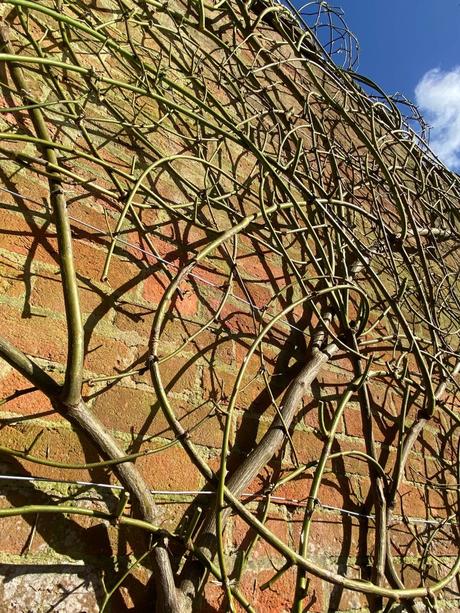
Cor, it’s been a while since I’ve blogged, but having been on such an inspiring rose pruning day with Jenny ‘Niff’ Barnes at the gorgeous Cottesbrooke Hall and Gardens last week, I just couldn’t contain myself.
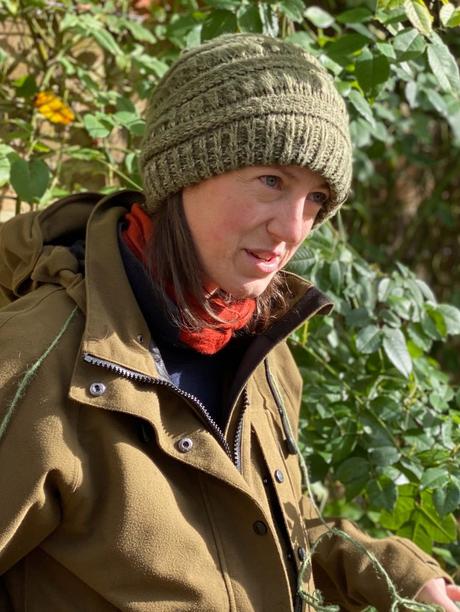
I love rose training, but Jenny Barnes (above) takes this art to a higher level. Her objective is to create a structure that is aesthetically pleasing throughout the winter months (although this rather glorious framework won’t be visible once the rose is in flower come summer).
Niff isn’t sure that you necessarily get more blooms with this style of training, but loves the look of it and aims to produce single layer framework, with evenly spaced stems. This structure won’t be completely flat, but she ties stems tightly to the wires or wherever they cross over each other, to keep the structure as flat as possible (unless really going for a 3D sculptural object). Unlike more traditional, received wisdom, where one is advised that rose stems should never cross, Jenny’s stems are cajoled and curved and tied in again and again, until a cage-like structure is formed as above. As long as the stems are tied firmly together, they shouldn’t suffer from any rubbing or damage. Niff uses any good twine, tying the stems firmly with a double knot.
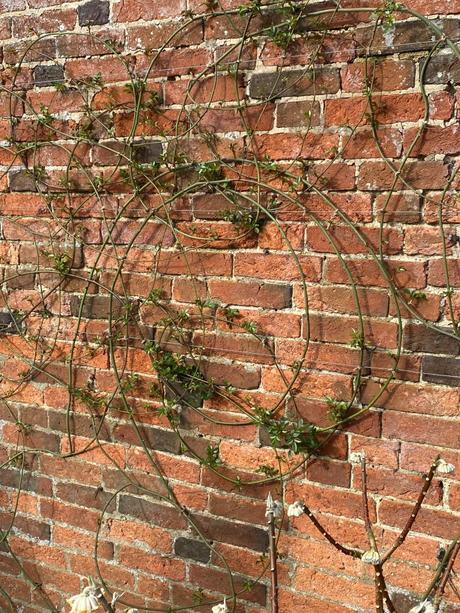
So how do you get started? Well, if you’re going to start with a new rose, Ramblers are recommended for curving and bending along walls as their stems are much more wiry and pliable than most Climbers. I think this is a one year old François Juranville above (a very tall, repeat flowering coral-pink Rambler), just starting out on its twirly journey, with relatively thin stems. Over the years, existing trained stems will thicken and this pattern can be spread over the rest of the wall with the new stems that are produced each year.
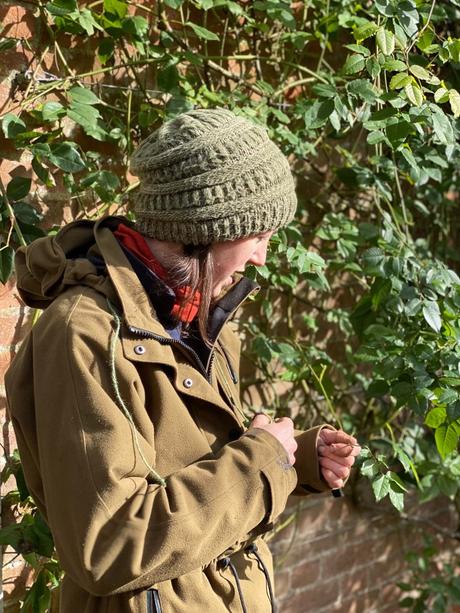
Roses are pruned between November and March during the dormant season, although this year, I found many roses still had their leaves well into the New Year.
Firstly, all the old leaves are taken off from ground level upwards so that you can get a clearer picture of what needs to be pruned and trained and as most pests and diseases are carried on the leaves, this is great for the health of the rose. Plus the final (leaf-less) structure will look clean and crisp. As ever, remove any dead, damaged or diseased wood before you really get going. Cut off the previous year’s flower heads, shorten all side shoots to a couple of healthy buds (about an inch (2.5cm) long from the main stems) and remove any growth that is thinner than a knitting needle.
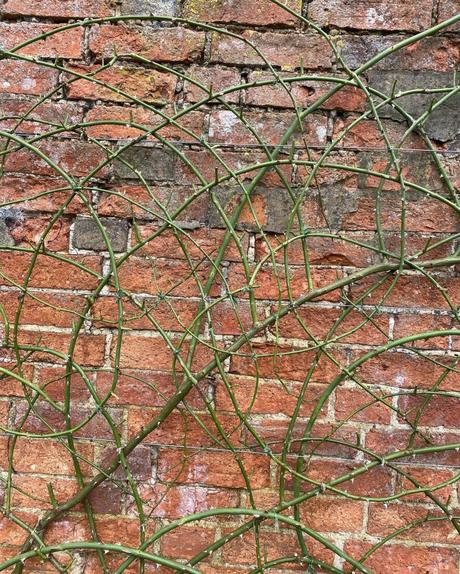
Above is Rosa ‘City of York’, further down its training path, where Jenny has manipulated the stems to fill gaps, again, keeping the rose to a single layer by tightly tying in the stems to each other and onto the wires.
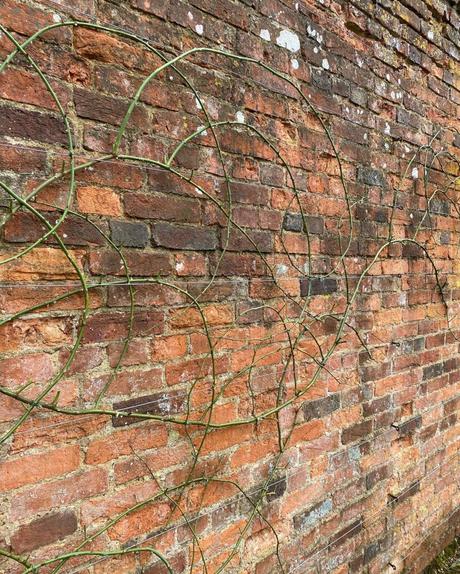
This is the same rose (above), with the newer growth being trained further along and up the wall. The rose stems all have their own natural direction of growth, so work with this to create curves and loops to fill in the spaces. This won’t all be achieved in one go, but can be built on every year until the design you want is achieved. Remember, there is no wrong way of doing this! You can create a design to your own aesthetic.
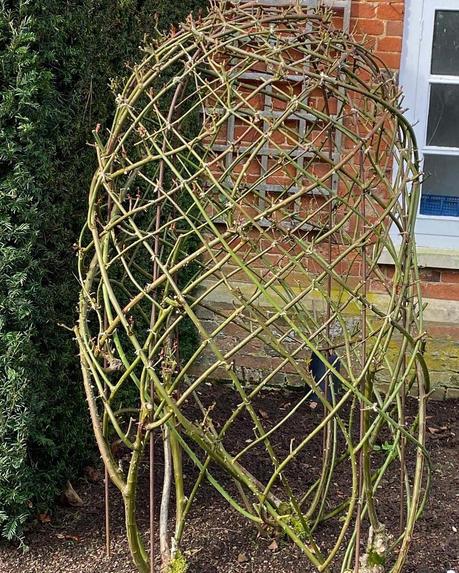
Free-standing structures can be created by training roses around a metal or wooden frame. This works well with with smaller climbers, whose stems are more rigid and less flexible. This could be ‘The Generous Gardener’ (a medium sized, pale-pink, scented, repeat-flowering climber) above.
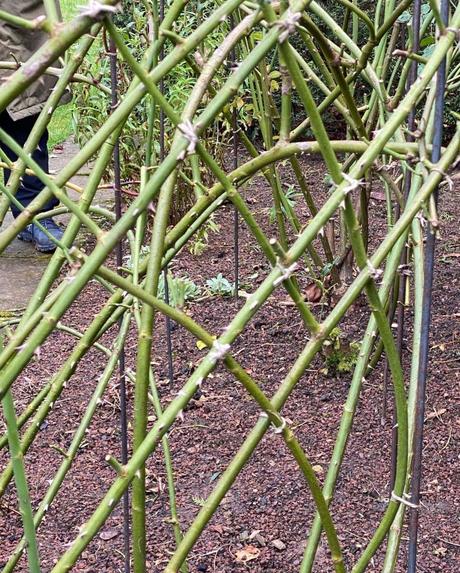
An even spaced lattice work pattern is created as stems are wrapped around the frame at the same angle at different heights, then tied to each other as they cross each at 90 degrees. Again, all sides shoots are cut back to a couple of buds (around an inch (2.5cm) long) to create a clean, tight shape
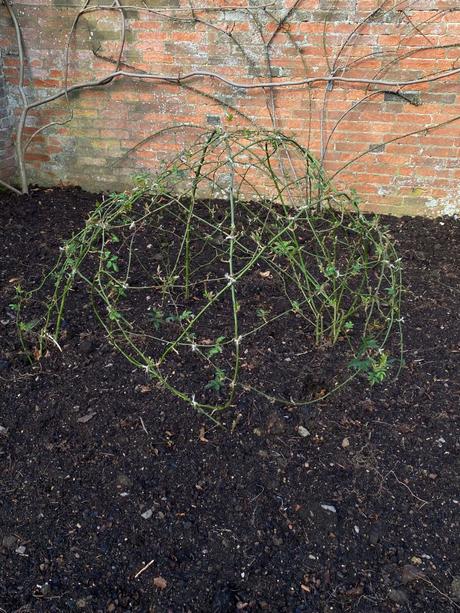
And roses without supports are also being grown in the borders, being trained and tied in to each other as they grow. Here are four ramblers starting out as a small dome, but plans are to create a large (around 2m tall) structure over the years, reshaping and re-tying-in the stems each year. Can’t wait to see how it grows!
Feeding All the roses are fed regularly throughout the year.
In Winter, they receive a large handful of blood, fish and bone and a large shovel of manure.
From April-October Week1-general seaweed feed, Week 2- Uncle Tom’s Rose Tonic,
Week 3- They are sprayed with Rose Ultra, Week 4 -nothing. This is repeated monthly.
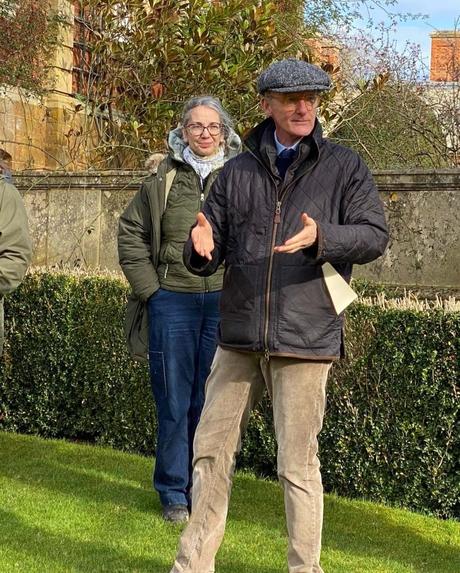
Alistair Macdonald Buchanan (above) is the owner of Cottesbrooke Hall , a most splendid Queen Anne manor house sitting amongst 13 acres of gardens. His enthusiasm for developing all areas of the land is palpable, as is his support for Jenny and her rose-training skills. It was a hugely enjoyable and informative day, warmly hosted by Alistair and Jenny, and I can’t wait to get back to the gardens in summer to see the roses in full bloom and to visit the newly planted borders.
You can keep up to date with Jenny’s activities on Instagram https://www.instagram.com/niff_barnes/ and https://www.instagram.com/cottesbrooke.estate/
And here are some of the roses that were mentioned throughout the day, some of which are already on our shopping list:
François Juranville A coral-pink repeat-flowering Rambler
Ethel A vigorous pale-pink summer flowering Rambler (new planted to clamber over the walls behind Alistair in the image above)
Adelaïde D’Orléans Sprays of delicate white double roses, once-flowering Rambler
Paul’s Himalayan Musk A whopper (40ft growth) of a Rambler. Once flowering and pale pink with a strong scent
Madame Alfred Carrière A tall, reapeat-flowering white Climber with a fruity scent and almost thornless
City of York Medium-sized, repeat-flowering, white. scented Rambler
Rosa Raubritter A gorgeous procumbent (ground-cover) rose, that can be trained as a climber. Mid-pink peony-like blooms from Trevor White Roses
Cécile Brüner Very tall Climber with pale-pink scented repeat-flowering blooms
The Generous Gardener Pale-pink, mid-sized, myrrh-scented, repeat-flowering, Climber
Wedding Day Another very large Rambler with clusters of small white, highly-scented roses. Perfect for extra-large sculptures!
